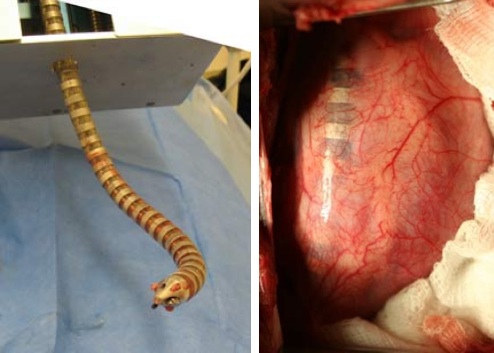Snakes on a (Surgical) Plain
 Laparoscopic and robotic surgery has been the standard for a number of abdominal and pelvic surgical procedures for some time, but researchers are now pushing the envelope further with “keyhole” and “pinhole” surgery using ever smaller and more flexible robotic tools. One recent advance, called CardioARM(tm), is being developed jointly by Carnegie Mellon University and Cardiorobotics, Inc. The CardioARM(tm) is a Cardiac Articulated Robotics MedProbe.
Laparoscopic and robotic surgery has been the standard for a number of abdominal and pelvic surgical procedures for some time, but researchers are now pushing the envelope further with “keyhole” and “pinhole” surgery using ever smaller and more flexible robotic tools. One recent advance, called CardioARM(tm), is being developed jointly by Carnegie Mellon University and Cardiorobotics, Inc. The CardioARM(tm) is a Cardiac Articulated Robotics MedProbe.
This articulated snake-like robot has a series of joints that automatically adjust to follow the course plotted by the robot’s head. This provides greater precision than any flexible endoscope can offer. The robot is operated using a computer and a joystick. It reportedly has 102 degrees of freedom, three of which can be activated at once. This allows the “snake” to enter through a single point in the chest and wrap around the heart until it reaches the right spot to perform the procedure. The “snake-like” design allows each joint to follow exactly where the previous joint went in 3-dimensional space, so that you can thread your way to the critical location and not have to worry about the “body” of the snake “bumping into” an important anatomic structure or tissue. A working channel or lumen in the probe, allows tools to pass through and perform various procedures.
At present, the smallest version of the device is 300 millimeters (about 1 foot) long and has a diameter of 12 millimeters (about 1/2 inch). The goal of the Carnegie Mellon University researchers however, is to make a “snake” small enough to enter the bloodstream through a blood vessel, says Marco Zenati, one of the principal researchers on the CardioArm project and a professor of surgery at the University of Pittsburgh. Zenati teamed up with Howie Choset, known for his work at CMU on crawling robotic snakes, and Alon Wolf, founder and director of the Biorobotics and Biometrics Lab at Technion, the Israel Institute of Technology. According to Choset, the Cardiorobotics team has performed successful cardiovascular surgeries on nine pigs and two human cadavers. Human trials are scheduled to begin soon.
The quest for smaller and less invasive surgical techniques is advancing rapidly. Microlaparoscopy, or pinhole surgery, uses much smaller surgical instruments (about 1/10th of an inch in diameter) than are found with laparoscopic techniques (about 1/2 of an inch in diameter). The technology is very new in the United States, and it is currently used primarily for diagnostic procedures. While laparoscopy usually requires general anesthesia, microlaparoscopy can be done with a local anesthetic and minor sedation. And as the name implies, pinhole surgery offers even smaller incisions than are commonly found today with laparoscopy. Blood loss is minimized, there is less tissue damage and recovery time from surgery is greatly reduced. Some of the early pioneers of minimally invasive techniques are found at the MIOT (The Madras Institute of Orthopedics and Traumatology) Hospitals in India.
Benefits of pinhole or keyhole robotic snakes include the fact that the human arm and the human-controlled instruments have a limited number of degrees of field. So you might be able to move an arm in/out, rotate or twist, but if you have a lesion that is behind the heart, you actually have to move the heart somehow in order to get behind the heart to remove a tumor or operate on a blood vessel. A robotic device that can articulate and move in many ways that a human arm cannot carries great promise. This is only one of several ways in which robots can assist in the operating room. By reducing the need for direct human intervention, a robotic surgical system can help the surgeon endure a long procedure. Many types of surgery can last from 8 to 10 hours. Sitting at a computer console using a joystick instead of standing and repeatedly having to hold and manipulate instruments can reduce the fatigue of the operation and can keep the hand and mind steady.
Related Links:
Robotic Surgery – http://electronics.howstuffworks.com/robotic-surgery1.htm